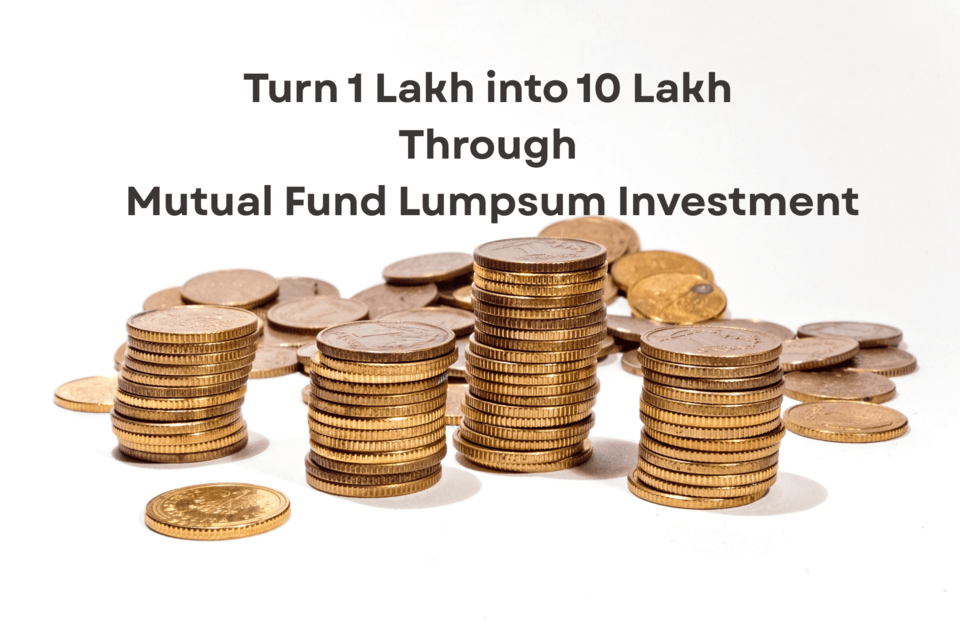Turn Rs 1 lakh into Rs 10 lakh through mutual fund lumpsum investment. Explore timelines for 11%, 15%, and 20% returns.
💡 Introduction

Can a single investment of Rs 1 lakh grow into Rs 10 lakh over time? The answer is yes, thanks to the power of compounding in mutual fund lumpsum investment. Mutual funds, especially equity mutual funds, offer a compelling route for wealth creation when you invest for the long term and let the returns compound.
In this guide, we’ll break down how a lumpsum of Rs 1 lakh can grow tenfold, how returns impact the time frame, and what kind of strategy investors should adopt.
📈 The Magic of Compounding in Mutual Fund Lumpsum Investment
Compounding allows your money to earn returns not just on the principal but also on the accumulated returns over time. The longer you stay invested, the faster your wealth grows.
We’ll use this standard compound interest formula:
A = P × (1 + r)ⁿ
Where:
- A is the final amount
- P is the principal (₹1,00,000)
- r is the annual return rate
- n is the number of years
📊 How Long Will It Take to Reach Rs 10 Lakh at 11% Annual Return?
Imagine you invest ₹1 lakh in a Mutual Fund Lumpsum Investment that gives an average annual return of 11%. Thanks to compounding, your investment will keep growing year after year.
Now, how long will it take to grow to ₹10 lakh?
Let’s simplify the math:
- You want your money to become 10 times (from ₹1 lakh to ₹10 lakh).
- With an 11% annual return, it will take about 24.15 years to grow tenfold.
So, if you invest ₹1 lakh once and just stay invested, you could reach ₹10 lakh in a little over 24 years without adding anything more!
🚀 What If Returns Are Higher: 15% or 20%?
| Annual Return | Years to Reach ₹10 Lakh |
|---|---|
| 11% | 24.15 years |
| 15% | 16.07 years |
| 20% | 12.20 years |
As seen above, even a small increase in return can significantly reduce the time required to reach your goal. But remember: higher returns come with higher volatility and risk.
⚖️ Risk vs Reward

- 11% Returns: Generally seen in diversified equity mutual funds with moderate risk.
- 15% Returns: Possible with mid-cap or thematic funds, but with higher volatility.
- 20% Returns: Historically rare and typically short-term. May come with high-risk sector funds or during bull markets.
Risk tolerance, investment horizon, and financial goals should guide your mutual fund choice.
🧠 How to Make This Work for You
- Pick the Right Mutual Fund: Prefer equity mutual funds with a strong long-term track record.
- Be Patient: Let compounding do the work. Time is your biggest ally.
- Avoid Panic Selling: Stick through market corrections.
- Choose Growth Option: Helps reinvest gains for maximum compounding.
- Rebalance Periodically: Review your portfolio once a year.
👤 Who Should Try This Strategy?
- First-time investors with ₹1 lakh to spare
- Parents planning for a child’s higher education
- Individuals targeting long-term wealth creation
- Anyone who wants to grow a small amount of capital steadily
🧾 Conclusion
With patience, discipline, and the right mutual fund lumpsum investment, turning Rs 1 lakh into Rs 10 lakh is not a dream, it’s a calculated outcome. Understand your risk appetite, choose your funds wisely, and let time and compounding do the heavy lifting.
🔍 FAQs
❓ Can I really turn Rs 1 lakh into Rs 10 lakh?
Yes, with consistent long-term returns (11–15%) and a long investment horizon, it’s achievable.
❓ Is SIP better than lumpsum?
SIP is ideal for regular savers. But if you have Rs 1 lakh ready, a Mutual Fund Lumpsum Investment lets you benefit from early compounding.
❓ Which mutual fund type is best for 10x growth?
Equity mutual funds, especially flexi-cap or mid-cap funds, offer the best potential over 15–25 years.
❓ What if I withdraw before reaching Rs 10 lakh?
You can exit anytime, but early withdrawals can reduce your corpus significantly due to compounding interruption.
❓ What are the taxes I should know about?
Long-term capital gains over Rs 1 lakh annually are taxed at 10%. Gains under Rs 1 lakh are tax-free.
❓ Can I add more to this investment later?
Yes, but that would change the corpus target. This example assumes a single Rs 1 lakh investment.
❓ Is it safe to expect 20% annual return?
Not consistently. While some years may yield high returns, sustained 20% annual growth is highly aggressive and risky.
❓ Should I consult a financial advisor?
Absolutely. A qualified advisor can guide you in fund selection, risk assessment, and goal planning.
Disclaimer:
Investing in mutual funds is subject to market risks. Consult your financial advisor before making any investment decision. Past performance is not indicative of future results.

